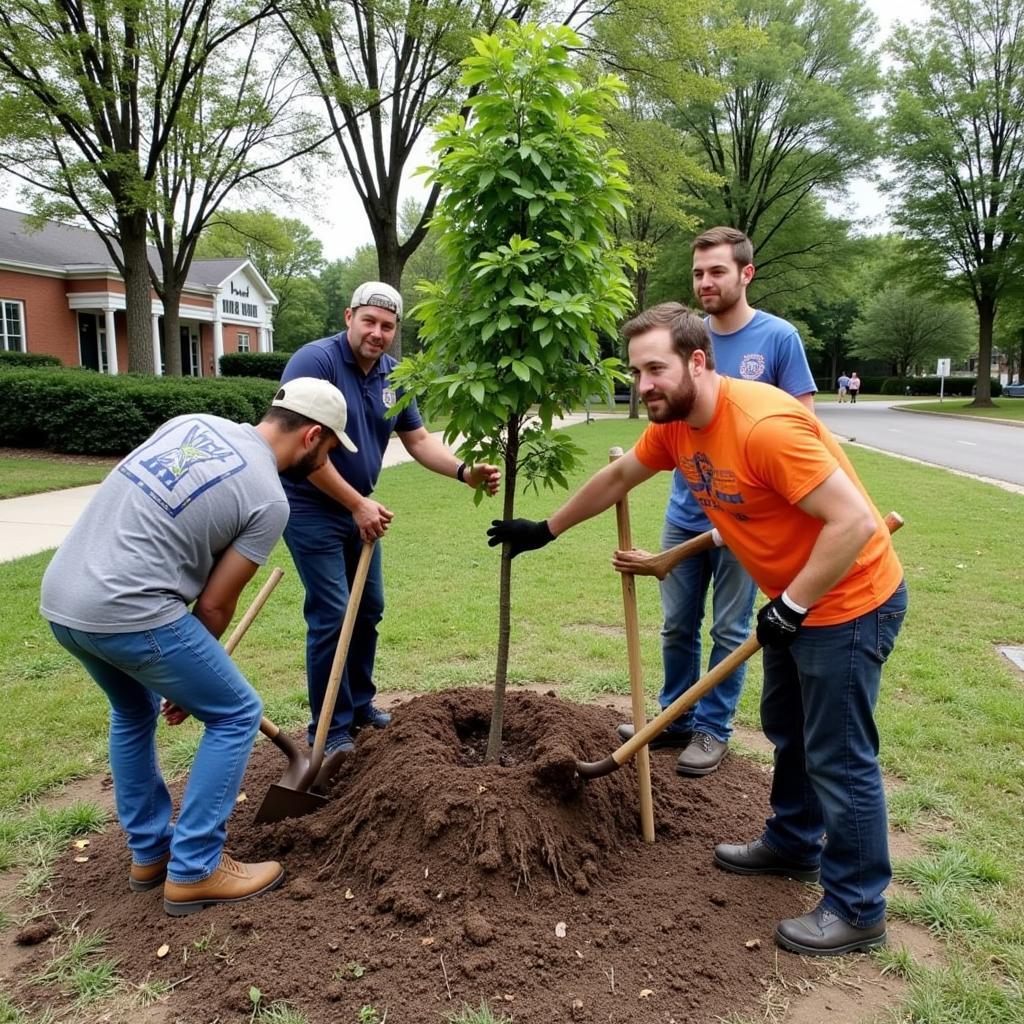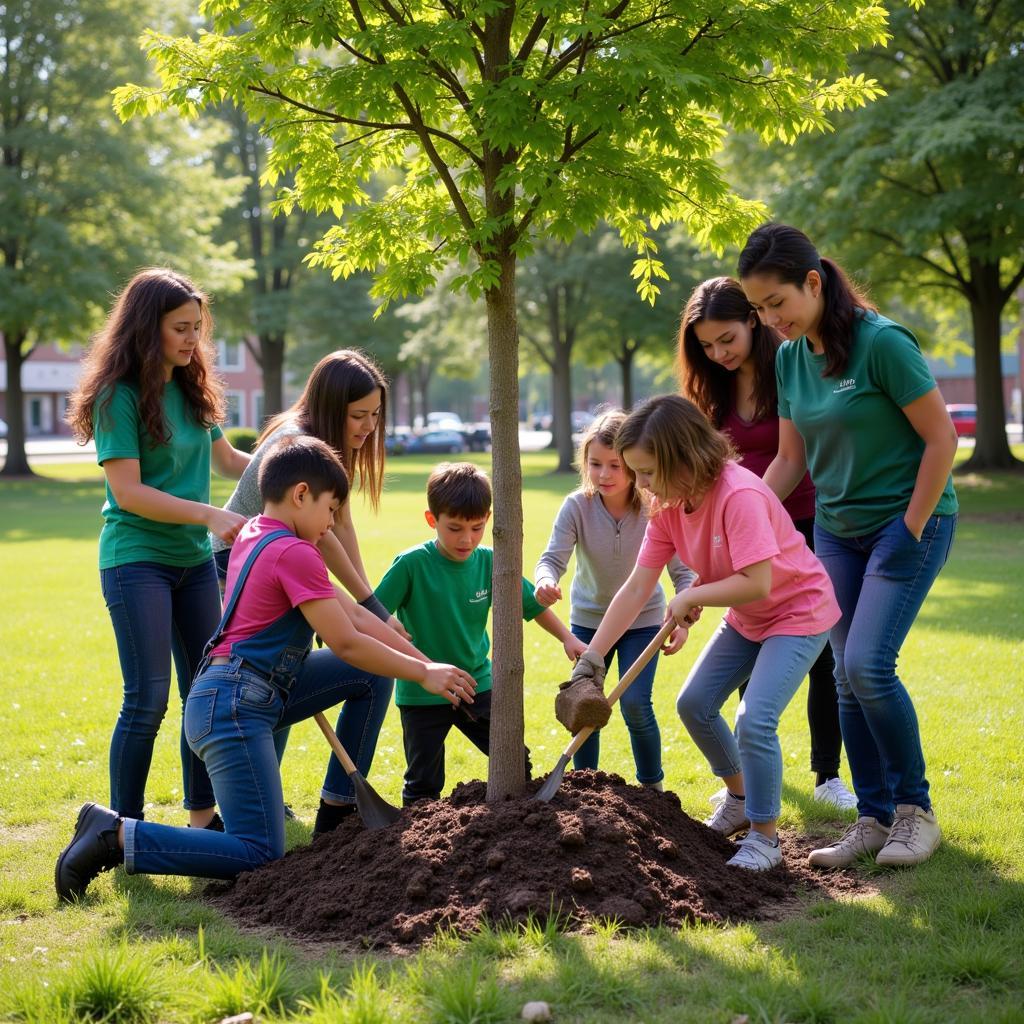The Society Of Municipal Arborists (SMA) plays a vital role in shaping the urban landscapes we live in. This dedicated group of professionals is at the forefront of cultivating healthy, vibrant, and resilient cities through the power of trees. But their work extends far beyond just planting and maintaining trees; they are champions of environmental stewardship, community engagement, and sustainable urban development.
 Municipal arborists working together to plant a tree in an urban park
Municipal arborists working together to plant a tree in an urban park
The Roots of Urban Forestry: Why Cities Need Arborists
The concrete jungle, while a testament to human ingenuity, often lacks the natural elements essential for a thriving ecosystem. This is where the role of municipal arborists becomes critical. They understand the unique challenges and opportunities that urban environments present for trees and work tirelessly to address them.
From mitigating the urban heat island effect to improving air quality, the benefits of a well-managed urban forest are multifaceted:
- Environmental Resilience: Trees act as natural air filters, absorbing pollutants and releasing clean oxygen. They also help manage stormwater runoff, reducing the risk of flooding and erosion.
- Climate Change Mitigation: Urban trees sequester carbon dioxide, helping to offset greenhouse gas emissions and combat climate change.
- Enhanced Quality of Life: Green spaces in cities have been proven to reduce stress, improve mental well-being, and foster a sense of community.
- Economic Benefits: Trees increase property values, attract tourism, and reduce energy consumption through natural cooling.
Branching Out: The Diverse Roles of a Municipal Arborist
The scope of work for a municipal arborist is surprisingly diverse. They are involved in:
- Tree Inventory and Assessment: This involves identifying and cataloging every tree within the city limits, assessing their health, and identifying potential risks.
- Planting and Transplanting: Selecting appropriate tree species for urban environments, ensuring proper planting techniques, and overseeing the successful establishment of new trees.
- Tree Maintenance: This includes pruning, fertilization, pest and disease management, and structural support to ensure the longevity and safety of trees.
- Risk Management: Identifying and mitigating potential hazards posed by trees, such as falling branches or root damage to infrastructure.
- Community Engagement and Education: Raising public awareness about the importance of urban forestry, organizing tree planting events, and educating residents about proper tree care.
Cultivating the Future: Challenges and Opportunities in Urban Forestry
While the importance of urban forestry is increasingly recognized, municipal arborists face ongoing challenges:
- Limited Resources: Budget constraints often limit the scope of urban forestry programs and the ability to implement innovative solutions.
- Development Pressures: As cities grow, trees often compete for space with infrastructure and development projects.
- Climate Change Impacts: Extreme weather events, pests, and diseases exacerbated by climate change pose significant threats to urban trees.
Despite these challenges, there are exciting opportunities on the horizon:
- Technological Advancements: New technologies, such as remote sensing and data analytics, are improving tree inventory and health assessments, allowing for more efficient resource allocation.
- Green Infrastructure Integration: Incorporating trees into urban design from the outset, rather than as an afterthought, is gaining momentum.
- Community-Driven Initiatives: Empowering citizens to participate in tree planting and care fosters a sense of ownership and stewardship.
Investing in Our Urban Canopy: A Shared Responsibility
The work of the Society of Municipal Arborists and their commitment to creating greener, healthier cities deserves our recognition and support. By advocating for increased funding, promoting sustainable urban planning, and engaging in community efforts, we can all contribute to a future where trees thrive alongside us in our urban landscapes.
Frequently Asked Questions about Municipal Arborists
1. What qualifications do municipal arborists need?
Municipal arborists typically hold a degree in forestry, arboriculture, or a related field. Many are certified by organizations like the International Society of Arboriculture (ISA), demonstrating their knowledge and expertise.
2. Who do I contact about a hazardous tree in my neighborhood?
Contact your local city or town government and inquire about their tree removal or urban forestry department.
3. Can I plant a tree in front of my house, and what is the process?
Many municipalities have regulations regarding tree planting on public property. Contact your local government for information on permits, approved tree species, and planting guidelines.
4. How can I get involved in supporting urban forestry in my community?
Look for volunteer opportunities with local tree planting organizations, attend city council meetings to advocate for urban forestry initiatives, or simply educate yourself and your neighbors about the importance of trees.
 Community members of all ages work together to plant trees in a local park
Community members of all ages work together to plant trees in a local park
Contact Us:
For support and inquiries, contact us at:
Phone: 02043854663
Email: [email protected]
Address: Khu 34, Bắc Giang, 260000, Việt Nam
We have a dedicated customer support team available 24/7 to assist you.